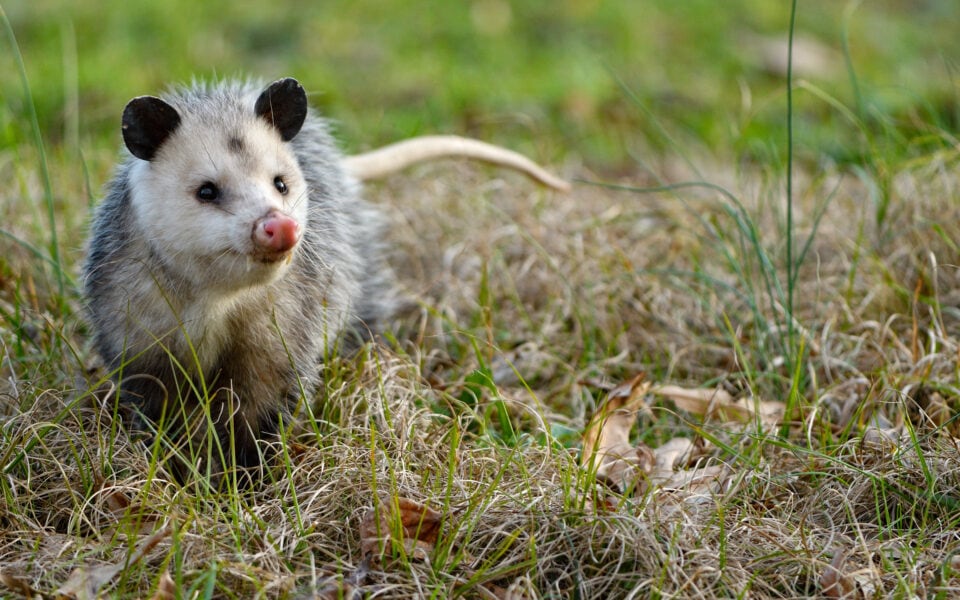Ground nesting birds in America have a host of common nest predators, including raccoons, skunks, fox, opossums, coyotes and snakes to name a few. Fire-ants are a serious threat in the southern states where the newly hatched chicks don’t stand a chance against the ravenous onslaught of a bed of these vicious killers. A change in rural lifestyles over the past 50 years has resulted in fewer small farms and as a result, a dramatic increase in the populations of predators. The aforementioned critters were serious threats on the farm and farmers kept a shotgun or rifle ready to deal with the issue.
Dealing With Nest Predators
Trapping and shooting are far and away the most popular options for dealing with nest predators. However each critter requires a little different approach. Before we jump into techniques and tactics, it’s essential that you know and understand your state’s game laws governing the removal of predators and/or nuisance wildlife. Most states have a list of animals that are considered a nuisance and can be killed or trapped at just about any time of year – but the laws are not consistent from one state to another.
Raccoons
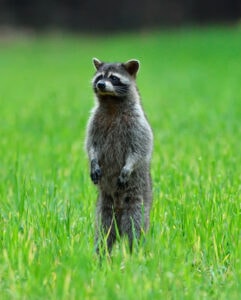
Tes Jolly
Raccoons are notorious nest predators. The “masked bandits” have been proven to be a cruel and efficient hunter of turkey, quail, and pheasant nests and usually eliminate a complete clutch at one time. Raccoons are credited with being intelligent and resourceful. This statement is proven by the fact the critters have learned out how to be “nest hunters” where timber stand thinning has occurred. Timber managers remove a strip of young timber and leave an adjoining strip as a management tool. Raccoons have learned to cruise the cleared strip, searching for the smell of the hen (or nest) in the remaining, unharvested strip. Mothers teach their young and soon the imprinting is done.
Raccoons are resourceful, and this leads to their demise. Game managers who install game cameras at feeding sites will agree raccoons are frequent visitors to those sites. A common and inexpensive method of trapping raccoons is with a leg-hold trap commonly called a dog-proof trap. A steel cylinder with a trigger mechanism in the bottom can be baited with a wide variety of offerings. When the ‘coon reaches in to take the food morsel it trips the trigger and becomes trapped. A chain or cable secures the trap to a tree or spike, holding the little thief until the trapper arrives to dispatch the culprit.
“The “dog-proof trap” has been a top performer for me and many of my friends,” Justin Rogers, a trapper and lure maker, said. “When using these traps I tell my customers to take a bag of large marshmallows along to stop up the hole in the top. The coon will simply remove the marsh-mallow and eat it or set it aside. So the function of the trap is unaffected. The use of the marshmallow is to prevent field mice or wood rats from crawling into the trap for the bait and triggering the trap. It’s discouraging to approach a trap and see a rat’s tail sticking out of the set.”
Dry dog or cat food is popular bait for the dog-proof traps, but Rogers’s company Old South Lures manufactures scented bait that adds to the appeal of the dry bait.
Once the traps are set and the raccoons are caught there is the necessity of dispatching the “nest-wrecker” and removal from the trapping locale. A .22 LR hollow point is a quick and humane way to dispatch the unlucky bandit. A handgun is a light and convenient tool for this. Modern air rifles, with muzzle velocities nearing 1,000 fps also do the trick with much less noise. Insure the animal is dead prior to releasing it from the trap and wear latex or nitrile gloves when handling the carcass as raccoons are a known reservoir for rabies.
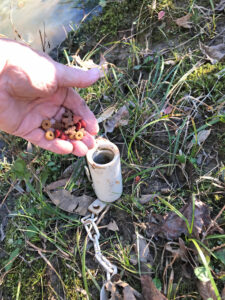 Raccoon pelts have some value on the fur market and the meat is eaten by some people. If you desire to save the pelt or give the carcass to a fur trader, a less destructive bullet in the ear is a better way to administer the Coupe-de-grace. If you choose to simply dispose of the body, there are ways to do that also. Read on to the baiting bobcats and coyotes section for a few tips.
Raccoon pelts have some value on the fur market and the meat is eaten by some people. If you desire to save the pelt or give the carcass to a fur trader, a less destructive bullet in the ear is a better way to administer the Coupe-de-grace. If you choose to simply dispose of the body, there are ways to do that also. Read on to the baiting bobcats and coyotes section for a few tips.
Have-a-heart traps will also catch nest destroyers. These trap-door devices are also a top means of catching raccoon, opossums, mink, and skunks – the latter, being a good catch, albeit a smelly one. Dispatch and disposal of the caught critters is the same as is described above.
Shooting nest destroying culprits is an iffy proposition. Raccoons may or may not have a season, depending on your state regulations. Those hunters who search the trees for squirrels will often encounter raccoons spending the day in a squirrel nest. Shooting into a nest may kill the resident, but vines or limbs may prevent the creature from falling to the ground for recovery. Shaking a vine or nearby sapling may encourage the animal to flee the nest, allowing the hunter/shooter to make a decision on dispatching the animal. This method of hunting will account for a few raccoons, but not nearly the quantity taken by trapping.
No matter the method of trapping you choose, run the trap line every day. You may want the pest to be gone, but there is no excuse for making it suffer needlessly. Trap placement is best along diches and small streams where mud or sand bars allow these hunting vermin to forage for food. Look for the distinctive long-toed foot-prints these critters leave in the soft earth and where you find fresh tracks – place traps.
Game feeders dispensing corn are another prime location for trapping raccoons. No doubt you have a trail camera at the feeder to record big game, so you have a jillion pictures of raccoons, coyotes and other grain eating varmints. The leg of the secured feeder makes a perfect place to anchor a dog-proof trap.
Coyotes, Bobcats, Badgers and Foxes
Coyotes, bobcats, badgers and foxes can be attracted to trap sets by tempting scents. These larger predators can be attracted to traps sets by tempting scents and will also respond to calling. Coyotes and cats will often circle downwind to pinpoint their prey before moving in and exposing themselves.
When trapping, covering the scent around the trap is just as important as when hunting, properly choosing a blind that gives you the wind direction advantage. Prepare yourself for hunting these larger varmints just as you would for hunting a trophy buck. Concealment and scent proofing should be paramount in every setup.
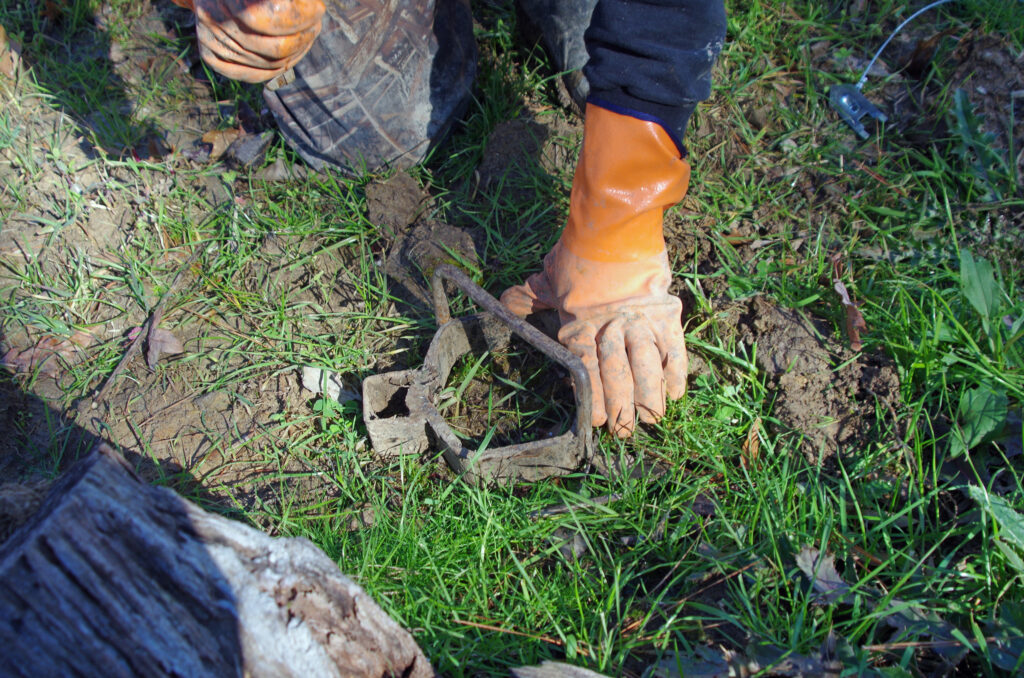
Keep a blind or shooting house brushed-in and/or unchanged all the time. Just like deer, coyotes will notice even a subtle change in their environment, a dark spot or a movement in the blind that is out of place or normally isn’t there will send them scurrying. They will relate the calling to the difference and avoid future calling in the same place.
If possible, setup your call and decoy at least 50 to 75 yards away from your shooting position. In the blind, keep the firearm completely inside the enclosure, just as military snipers do during urban warfare. Using an electronic caller is better than a mouth call because the animal is attracted to the sound and sight of the decoy. An added scent is then, just a bonus. Remember you want the animal concentrating on the sound and sight of the decoy and not on you. There are hundreds of call sounds and they all work to some degree. Don’t wear out your welcome by using the same sounds over and over.
Any rifle decent for shooting a deer is adequate in both power and accuracy for shooting varmints at reasonable ranges. A modern sporting rifle is fine choice for a quick follow-up shot, should one have the opportunity or need. You will seldom see a pack of coyotes attack a target as a group, but pair hunters are frequent. Bobcats almost always are singular in their approach.
A deer gut pile earlier can become a great place to place a blind and ambush the four-legged scavengers. At our place, we have perfected an experiment, already conducted with much acclaim by a Russian scientist named Ivan Pavlov. He’s the guy who made the term “conditioned response” a household term.
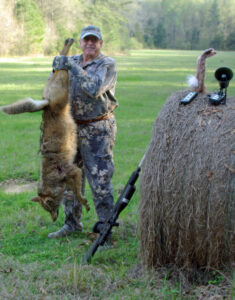 We use a plastic gut bucket and empty it with several loud thumps whenever we dump offal. We do the same when we have fish guts, unwanted raccoon carcasses, unwanted feral hogs or even road-kill too close to the house. It took only a few months for the coyotes to learn the “plastic tub noise” meant food on the ground.
We use a plastic gut bucket and empty it with several loud thumps whenever we dump offal. We do the same when we have fish guts, unwanted raccoon carcasses, unwanted feral hogs or even road-kill too close to the house. It took only a few months for the coyotes to learn the “plastic tub noise” meant food on the ground.
A spot light and night scope make the game complete. We use shotguns and on a good night will get multiple coyotes with the first volley.
Trapping “yotes” is a sure fire success for increasing recruitment for a number of game species on your property. Every farmer believes they have the God-given talent to do everything related to the land and its critters. While I am one of these believers there are just some things better handled by professionals. Trapping coyotes and bobcats takes patience and the kind of knowledge acquired from years of experience. Traps should be checked every day and several dozen should be scattered around in order to get the maximum effect. Setting a steel trap for a large predator is far more complicated than baiting and sticking a Z-Trap down for a raccoon.
“We try to set our leg-hold traps where the animal has to approach the bait from a desired direction,” said Robby Gilbert, producer of Trapping Time TV. “Many novices don’t realize we do not place bait in, or on, our trap. We hide the trap where the animal will step in it as they investigate the bait.”
Robby designed and made a cookie cutter that will take a trap-shaped plug out of the ground to allow the trap to have a firm base. The trap is attached to a steel chain and stake beneath the trap. The jaws are set and the trap is covered with peat moss, leaves and grass to resemble the surrounding area. Another hole has been made under the edge of a log, or pile of logs. The bait is placed in this hole and attracting scents are placed nearby. The log restricts the approach to the bait and betters the chance the animal will place a foot in the trap. At a successful site, the animal is removed and the trap reset. The bait may require refreshing, but not necessarily.
“When we move into an area to trap we are conscious of houses where free-roaming dogs may be active and try to set away from those places,” Robby said. “The last thing we want to do is harm someone’s pet. Some of the pelts are valuable enough to keep and sell in the fur market. Others are so low-priced right now the earnings do not support the business. As an example, a beaver pelt is only worth a few dollars, but the oil glands are used in the manufacture of makeup and perfume, thus fetching a better price.”
Solve the Problem from other Angles
Increasing the quality nesting habitat can have a huge impact. “Loss of native habitats, such as the conversion of grassland to cropland, is the primary threat to our native ground nesting birds,” said Travis Runia, Senior Upland Game Biologist with the South Dakota Department of Game, Fish and Parks. “Where intact habitat exists, excessive depredation is not a concern.”
“Striped skunks, Opossums, raccoons and badgers are the primary nest predators, but there are probably another half dozen species that will depredate pheasant nests,” Runia added. “The 4 primary nest predators listed above can be trapped or harvested year-round. Landowners do not need a license to trap/harvest those species on their own land.”
Snakes
Snakes are nest predators, but I could find no evidence they actively hunt the nest and raccoons do. Many states have statutes that protect snakes (or at least certain snakes) from harm. Gray rat snakes also called chicken snakes are a common egg predator. They risked their lives in many a country henhouse and with a surge in backyard poultry production have again found an egg supply. In their defense, they also gobble-down many rodents such as rats and mice.
Here’s the deal, there is no recommendation printed here for dealing with snakes in the woodlands and fields where “Mr. No Shoulders” hangs his hat. Every year as gamekeepers take their tractors to the farm to clip, bush-hog and disk, snakes die. I’ve never seen anyone rush one to the veterinarian for care.
So there you have it, there is an abundant number of critters who are just looking for a meal, and game bird nests meet that requirement. There are an equally, maybe greater number of conservationists and hunters wanting to protect and expand the game birds we enjoy. Go forth and do right by the land.

